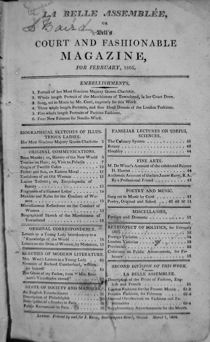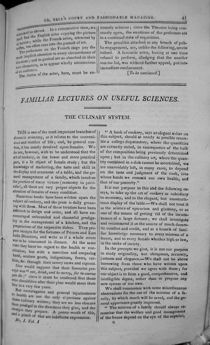|
La Belle Assemblée; or, Bell's Court and Fashionable Magazine, 1806–32 | |
Sequence |
Volume 1, 1806 |
Editor |
Unknown, 1806–31 |
Publisher |
John Bell, 1806–21 |
Printer |
John Bell, 1806–21 |
Price |
2s. 6d. [or 1s. 6d. for either 'division' separately] (1806) |
Format |
Royal 8vo. in 4s |
Pages |
54–64 (1806) |
Frequency |
Monthly |
Circulation |
Unknown |
Indexes |
All volumes |
Digital |
Digital versions of the La Belle Assemblée, vols 1–7 (1806–1809), n.s. vols 1–30 (1810–24), 3rd ser., vols 1–15 (1825–32) are available by subscription via British Periodicals. |
Copies |
Leeds University Library |
Introduction | |

When it first appeared in February 1806, La Belle Assemblée claimed to be 'an entirely original and most interesting work, addressed to the ladies'. However, the new magazine entered a market that was already well established. Periodicals directed particularly at leisured women had existed since the late seventeenth century, and with the success of the Lady's Magazine (1770–1837), the monthly magazine became an established form. The new magazine, however, had a distinctive flamboyance in its elegant combination of polite literature and illustrated accounts of the fashionable world. It was the production of John Bell (1745–1831), a printer and publisher of considerable reputation and style who was renowned for his puckishness and love of innovation, not least in introducing modern type-faces to British readers. As a newspaper proprietor over many years, Bell's success had been built in part on his interest in, and understanding of, fashionable society. His new venture exhibited these qualities, combining a lavish elegance of typography, illustration, and literary form with a perceptive appreciation of the interests of the beau monde. Its price reflected its intended market, and at more than twice the price of its main (one-shilling) competitors, it was clearly aimed at the most affluent and fashionable readers. Neither its title ('beautiful assembly') nor its subtitle ('Bell's Court and Fashionable Magazine') properly prepare the modern reader for the contents of La Belle Assemblée. Far from being an intellectually lightweight production, the magazine contained a serious admixture of biographies, fiction, scientific and other prose articles, poetry, music, reviews, political and theatrical news, as well as information about the latest fashions in dress. This was not atypical of women's magazines at this period and both the Lady's Magazine and the Lady's Monthly Museum (1798–1832) were similarly concerned with the mental cultivation of women, also including substantial scientific articles (Shteir 2004). While each number of La Belle Assemblée typically contained five plates—one depicting a member of the court or fashionable society, two depicting the latest fashions, and a further two providing sheet music and a sewing pattern—the magazine was not dominated by the frivolities of fashionable dress. Indeed, Bell separated the portion of the work dealing with the fashions of the month from the remainder of the publication. One could (at least initially) purchase either of the two divisions of the work separately; the first consisting of the bulk of the letterpress, together with two of the plates, the second ('La Belle Assemblée') consisting of the fashion plates and sewing pattern, together, usually, with four pages describing the plates and discussing the latest London and Paris fashions. La Belle Assemblée did not initially follow the Monthly Museum in having coloured plates, but (hand) colouring of one or two of the fashion plates was introduced at the start of 1807, following competition from a short-lived rival Le Beau Monde (vol. 2, p. iii; Adburgham 1972, p. 223). A final section of the magazine (not indexed here) was 'Bell's Monthly Compendium of Literary, Fashionable, and Domestic Advertisements; Forming the Commercial and Supplementary Part of La Belle Assemblee [...] Addressed to the Elegant, Polite, and Economical'. This was separately paginated, but Bell hoped that it would be 'bound up, and transmitted in this Work to posterity'.  Within the first division of the text, Bell subdivided the articles under headings, typically (in the first volume) 'Biographical Sketches of Illustrious Ladies', 'Original Communications', 'Beauties of Modern Literature', 'State of Society and Manners', 'Familiar Lectures on Useful Sciences', 'Fine Arts', 'Poetry and Music', 'Miscellanies', 'Retrospect of Politics', and 'Public Amusements'. In addition, each volume contained a supplementary number providing a 'Critical Review of the Most Distinguished Works of Literature'; these appeared, after the first, at six-monthly intervals. This carefully ordered layout was part of John Bell's conception of style. In his opening address to readers he claimed to have 'introduced a material improvement' in comparison with competitors in 'method, arrangement, and elegance of display'. Printed on untypically large (royal-sized) paper, and arresting in its use of modern type-faces, La Belle Assemblée certainly presented readers with a magazine distinctive in its spacious decorousness from the smaller Lady's Magazine and the yet smaller Lady's Monthly Museum. The identity of the editor during the early period is unknown. However, the fashionable novelist Elizabeth Inchbald (1753–1821) was at one period invited to fulfill the role (ODNB), and later editors included the well-known writers Laman Blanchard and Caroline Norton. From its inception, the magazine solicited contributions from readers, and many letters, articles, and poems were printed. Later, 'pecuniary recompense' was offered for contributions (Hayden 1986, p. 41). As we have seen, the price was such that the readership was unquestionably select, but no details of circulation have been found. The character of the magazine changed significantly in later years with the changing expectations of the role of women in British society, and, as with its competitors, the educational ambition and intellectual scope of La Belle Assemblée markedly diminished in the 1820s. In particular, the scientific articles declined significantly in the 1810s (Hayden 1986, p. 42; see also Shteir 2004). Under new ownership following Bell's retirement in 1821, the magazine became the Court Magazine and Belle Assemblée in 1832, and finally merged with the combined Lady's Magazine and Museum in 1837. | |
Notes on Indexing | |
 The indexing offered here for La Belle Assemblée is limited to the first volume. It is intended to provide a sense of the periodical for comparative purposes and as an inducement to pursue further research in this area. The references to science appear throughout the magazine, most obviously in the dedicated scientific articles, but also in other prose articles, fiction, poetry, and even in the fashion section. Articles on the 'useful sciences' relate to topics that might be anticipated—such as botany, perspective, eating, and the 'culinary system'—but also to more traditionally male gendered fields such as geology and mechanics. The sciences are also sometimes extensively treated in a wide range of essays and other articles on geography, history, literature, travel, manners, and other subjects, as well as in news reports. Other references are merely passing ones (as when the narrator of a tale observes: 'I felt, like the cameleon, capable of living upon air'), which are nonetheless potentially of interest. In light of the range of references to science, our indexing of La Belle Assemblée generally includes a brief description in order to help readers to identify relevant materials in articles where the title does not necessarily provide adequate context. | |
Bibliography | |
Adburgham, Alison 1972. Women in Print: Writing Women and Women's Magazines from the Restoration to the Accession of Victoria, London: George Allen and Unwin. Beetham, Margaret 1996. A Magazine of Her Own? Domesticity and Desire in the Woman's Magazine, 1800–1914, London: Routledge. Hayden, John O. 1986. 'La Belle Assemblée', in British Literary Magazines: The Romantic Age, 1789–1836, ed. by Alvin Sullivan, Westport CT and London: Greenwood Press, 40–45. Morrison, Stanley 1930. A Memoir of John Bell, 1745–1831. Bookseller, Printer, Publisher, Typefounder, Journalist, &c., Cambridge: for the author. Shteir, Ann B. 2004. 'Green-Stocking or Blue? Science in Three Women's Magazines, 1800–50', in Culture and Science in the Nineteenth-Century Media, ed. by Louise Henson, et al., Aldershot: Ashgate, 3–13. White, Cynthia L. 1970. Women's Magazines, 1693–1968, London: Michael Joseph. | |
Jonathan R. Topham (Nos. 1–4) and Fern Elsdon-Baker (Nos. 5–12) | |
© Science in the Nineteenth-Century Periodical Project, Universities of Leeds and Sheffield, 2005 - 2020
Printed from Science in the Nineteenth-Century Periodical: An Electronic Index, v. 4.0, The Digital Humanities Institute <http://www.sciper.org> [accessed ]